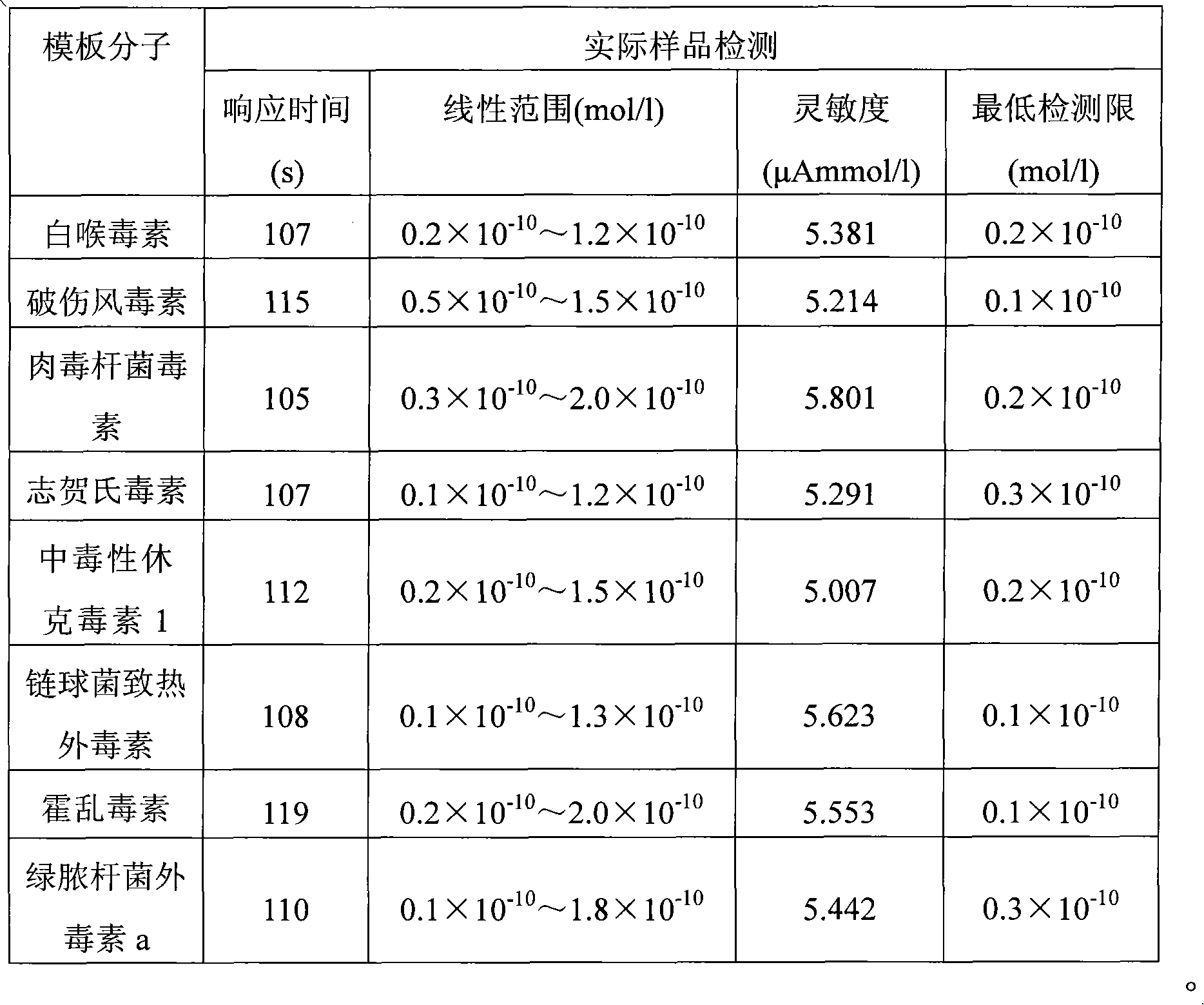Method for preparing glycosyl functional molecularly imprinted membrane electrode for detecting bacterial toxin and application thereof
A molecularly imprinted membrane and bacterial toxin technology, applied in the field of environmental pollutant detection, can solve the problems of time-consuming and laborious result accuracy, long cycle, complicated process, etc., and achieve the effect of low cost, strong specificity and high sensitivity
- Summary
- Abstract
- Description
- Claims
- Application Information
AI Technical Summary
Problems solved by technology
Method used
Image
Examples
Embodiment 1
[0028] A preparation method of glycosyl functionalized molecularly imprinted membrane electrode for detecting diphtheria toxin, including the following steps:
[0029] (1) Select functional monomer A-D-pyranosylmannose that can synthesize glycosyl functionalized molecularly imprinted polymer with diphtheria toxin;
[0030] (2) The template molecule diphtheria toxin, the functional monomer AD-pyranosyl mannose, the crosslinking agent ethylene glycol dimethacrylate (EGDMA), the porogen chloroform, and the initiator azobisisobutyronitrile, The organic solvent dichloromethane molar ratio is 0.1:2.5:0.5:70:0.05:2.0 and the mixture is evenly mixed to obtain the glycosyl functionalized diphtheria toxin molecularly imprinted polymer solution;
[0031] (3) The working electrode is a glassy carbon electrode. The surface of the working electrode is polished with 0.05μm alumina powder, ultrasonically cleaned, and then 1mol / L HNO is used. 3 , 1mol / L NaOH cleaned, then thoroughly cleaned several t...
Embodiment 2
[0035] Example 2 (Tetanus Toxin)
[0036] A preparation method of glycosyl functionalized molecularly imprinted membrane electrode for detecting tetanus toxin, including the following steps:
[0037] (1) Select the functional monomer sialic ganglioside that can synthesize glycosyl functionalized molecularly imprinted polymer with tetanus toxin;
[0038] (2) Template molecule tetanus toxin, functional monomer sialic acid ganglioside, crosslinking agent trimethylolpropane trimethacrylate, porogen dichloromethane, initiator azobisisobutyronitrile, organic The molar ratio of solvent methylene chloride is 0.5:2.5:3:45:0.1:5, and the mixture is evenly mixed to obtain a glycosyl functionalized tetanus toxin molecularly imprinted polymer solution;
[0039] (3) The working electrode is a glassy carbon electrode, the electrode surface is polished with 0.05μm alumina powder, ultrasonically cleaned, and then 1mol / L HNO 3 , 1mol / L NaOH cleaned, then thoroughly cleaned several times with double dis...
Embodiment 3
[0043] Example 3 (Botulinum toxin)
[0044] A preparation method of glycosyl functionalized molecularly imprinted membrane electrode for detecting botulinum toxin, including the following steps:
[0045] (1) Select the functional monomer N-acetylglycosamine that can synthesize glycosyl functionalized molecularly imprinted polymer with botulinum toxin;
[0046] (2) Combine template molecule botulinum toxin, functional monomer N-acetylglucosamine, cross-linking agent N, N-methylenebisacrylamide, porogen methanol, initiator azobisisobutyronitrile, organic solvent The molar ratio of dichloromethane is 1:2.5:5:65:0.08:15, and the mixture is evenly mixed to obtain a glycosyl functionalized botulinum toxin molecularly imprinted polymer solution;
[0047] (3) The working electrode is a glassy carbon electrode, the electrode surface is polished with 0.05μm alumina powder, ultrasonically cleaned, and then 1mol / L HNO 3 , 1mol / L NaOH cleaned, then thoroughly cleaned several times with double dist...
PUM
 Login to View More
Login to View More Abstract
Description
Claims
Application Information
 Login to View More
Login to View More - R&D
- Intellectual Property
- Life Sciences
- Materials
- Tech Scout
- Unparalleled Data Quality
- Higher Quality Content
- 60% Fewer Hallucinations
Browse by: Latest US Patents, China's latest patents, Technical Efficacy Thesaurus, Application Domain, Technology Topic, Popular Technical Reports.
© 2025 PatSnap. All rights reserved.Legal|Privacy policy|Modern Slavery Act Transparency Statement|Sitemap|About US| Contact US: help@patsnap.com


